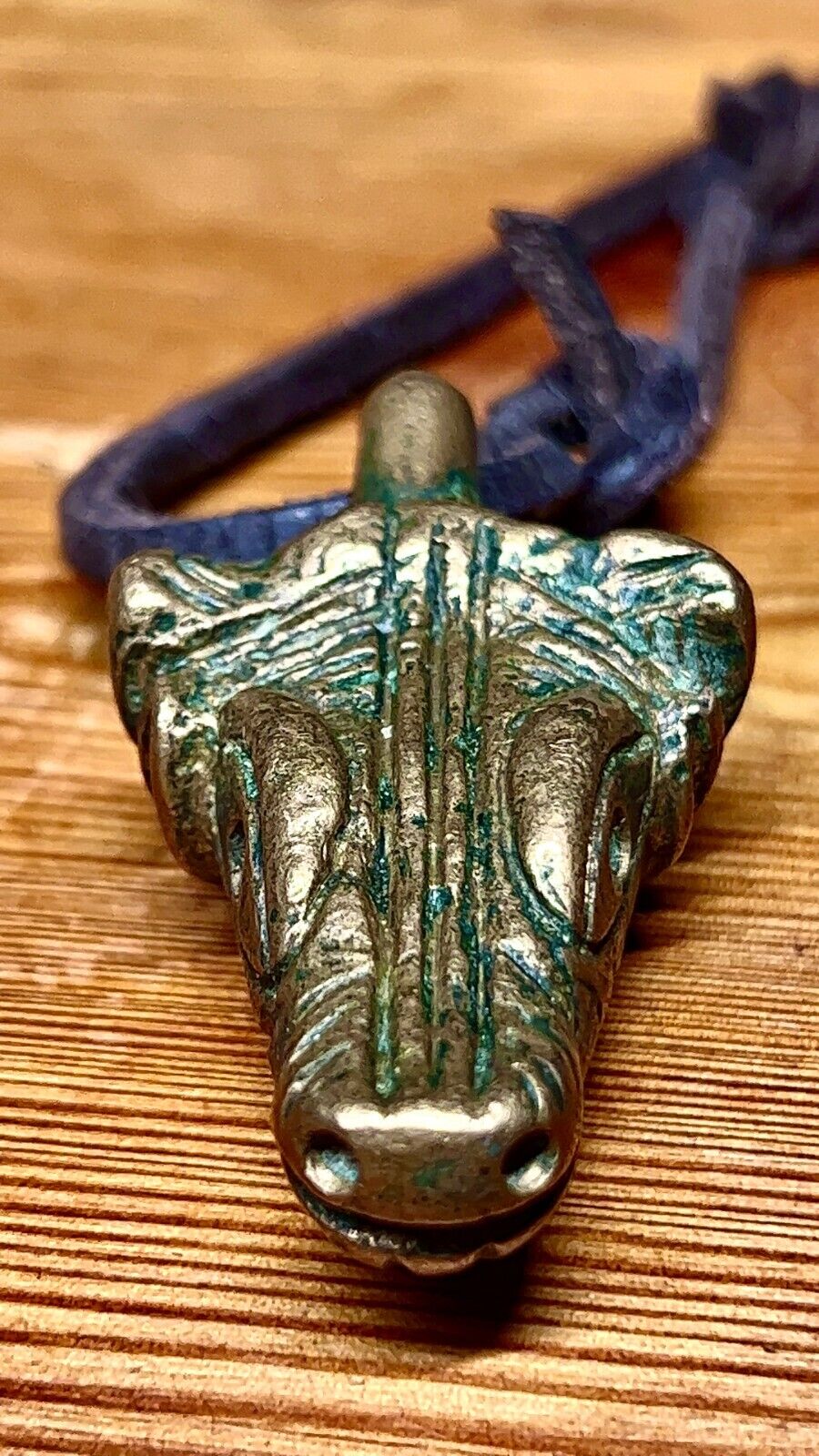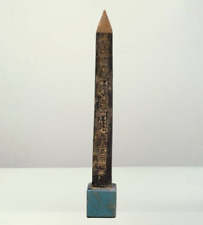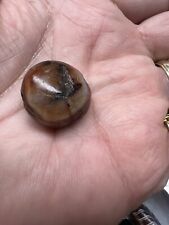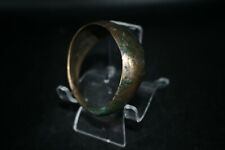When you click on links to various merchants on this site and make a purchase, this can result in this site earning a commission. Affiliate programs and affiliations include, but are not limited to, the eBay Partner Network.
Background on Barakat Antiquity:
*Note: Barakat Antiquity still exists today, and is - very - relevant in the world of artifacts of antiquity.
The Barakat Gallery is a fifth generation family owned and operated business, founded in Jerusalem over 125 years ago. Towards the end of 19th century, the family began amassing a sizable collection of items found in the surrounding hills of their Jordanian farmlands. Soon enough workers, farmers, and merchants from all over the region caught wind of the rapidly growing “Barakat Collection,” and had to see it for themselves. Some wanted to buy, some wanted to sell, some to trade, others wanted to just admire, and yet still others to learn. The incredible assortment of items was quickly manifesting iteself as not only a magnificent historical testament but also a viable business venture. And from these humble beginnings the Barakat Family, for over a century, has dedicated itself to acquiring the finest masterpieces of ancient art from around the world. Their curiousity, love, and appreciation for ancient art and artifacts has driven the collection to encompass the sacred relics of various cultures from all corners of the globe… everything from Pre-Columbian America to the Khmer civilization of Cambodia.
1961 – 1967: Fayez employed by Kathleen Kenyon in excavating Jerusalem. During the last few years becomes her most trusted assistant.
1963-70: Fayez assists Professor Nelson Gleck, Professor William Dealer, and Gerald A. Larue in both excavation and research. His most notable scholarly collaborations from this period were with Pierre Deveaux and Father Spiekermann.
1963/4: Fayez is introduced to preeminent Egyptian jeweller and antiquarian Emil Saad, who helped him acquire first masterpiece neither excavated or inherited in Palestine of a Nefertem sculpture from the Omar Sultan collection. This item since has become the gallery’s insignia and the gallery’s original concept was based on the symbolism of the deity’s openness to the world and culture as ‘the mirror of all ages and cultures’.
1967: First major gallery opened in Jerusalem’s Old City in partnership with family. Establishes first non-touristic antiquities collection recognised by the Israeli ministry of culture and tourism.
1967: Curates Moshe Dayan’s private art collection.
1969-71: Fayez initiates curatorial collaboration with Jiri Frel who introduces him to J.P. Getty.
Fayez acquires numerous pieces for the Getty collection.
1970 – 1982: Independently opens largest gallery of museum quality Near Eastern, Classical and Egyptian antiquities in Bethlehem.
1970-83: Fayez acquires inventory for billionaire Bob Cummings, as well as previous owner of Sotheby’s Alfred Taubman.
1983: Metropolitan Museum endorses Fayez’s application for US citizenship, and the Getty, Tom Bradley and Fred Croton advocated for the opening of Barakat Gallery in Los Angeles.
1993: Fayez sells original container of the Dead Sea Scrolls to the Martin Schoyen.
2007-2015: Abu Dhabi Gallery. Brought commercial non-Islamic antiquities for the first time to the UAE.
2016: Opening of Barakat Seoul.
2017: Opening of Hong Kong branch and relocation of Barakat Gallery in Beverly Hills to LCDQ
Background on Fayez Barakat:
As a young boy Fayez worked beside the famous British archaeologist, Dr. Kathleen Kenyon, sorting and identifying shards from her excavation in the ancient Jerusalem of King David’s time. Fayez became familiar with pottery classifications and with the basic principles of field archaeology.
His facility in learning languages was startling. With his photographic memory he could quickly master a new language, including vocabulary and grammar, and conduct intelligent conversations with visitors from different countries in Europe in their native languages.
At the age of fourteen, when he was deeply engrossed in reading medical textbooks in preparation for his intended career in medicine, he met Father James McGuire of Loyola University. The reverend father, as a good teacher, put Fayez to the test. He thumbed through the texts and asked questions of the young man. So impressed was he by Fayez’s answer that he offered him a Fullbright scholarship.
When the papers arrived in Jerusalem, Fayez’s father distressed at the thought of being separated from his son, quietly secreted the documents until the time for accepting the invitation had elapsed.
During 1967 artifacts from plundered tombs in the hill country west of Hebron began to stream into Jerusalem. Fayez, like other merchants, made purchases from the villagers. He acquired numerous common household objects from periods extending from Middle Bronze I (2100-1900 B.C. ) through the Byzantine era (A.D. sixth century). Soon he began to accept only those choice items that represented the finest statements of the ancient craftsman’s art.
About this same time, Dr. Nelson Glueck, president of Hebrew Union College, a world-renowned scholar and archaeologist, invited Fayez to attend classes in the Jerusalem school. Soon he was enrolled in courses taught by the eminent Middle Eastern archaeologist, Dr. William Denver. Under the guidance of Father Spiekerman, director of the Museum of the Flagellation at the Second Station of the cross in Jerusalem, he researched ancient coinage. He read and studied archaeological journals, excavation reports, and the best sources in art history. Consequently, he has become one of those unique individuals whose knowledge combines the results of classroom studies, extensive reading and research, and practical field experience with intimate familiarity with artifacts developed through handling thousands of items.
Today, Fayez is more than a merchant; he is a connoisseur devoted to a dream. He believes he owes something to the archaeologists and instructors who helped develop his expertise-and indeed, to all who probe the past and help us appreciate our rich human heritage. He has undertaken a duty to preserve the past and to save from possible damage and loss these exquisite artistic statements. He has witnessed the destruction of precious ancient objects by simple villagers who feared fines for possession of such items or perhaps confiscation by the government of the land on which they were found. Once an artifact is destroyed, whatever it might tell us of the past is beyond recovery and its usefulness as a clue to the understanding the creative spirit is forever lost.
Historical Summary of Legio X Equestris/Gemina:
Julius Caesar, during his tenure as the Governor of Hispania Ulterior in 61 BC, raised Legio X Equestris, a Roman legion. This particular legion held a significant role in Caesar's Gallic campaigns and was regarded as his most trusted force. Notably depicted in Caesar's Commentaries, Legio X's fame endured even after its members were discharged in 45 BC. Despite disbanding, some remnants of the legion were reconstituted and experienced subsequent engagements under Mark Antony and Octavian. Eventually, Legio X was merged into X Gemina.
Upon his appointment as Governor of Baetica or Hispania Ulterior (present-day Andalusia) in 61 BC, Gaius Julius Caesar swiftly made plans to conquer the western and northwest regions, which encompassed present-day Portugal. To supplement his existing forces, including the 8th and 9th Legions enlisted by Gnaeus Pompeius Magnus in 65 BC, Caesar immediately raised a new legion known as the 10th legion. Marching under the banner of a bull, a symbol that gained popularity among other legions such as Legio V Alaudae, Legio XI, Legio XII Victrix, and Legio XIII Gemina, the 10th Legion played a vital role in Caesar's triumphant campaign during the summer of 61 BC, highlighting their courage and unwavering loyalty to their commander.
Throughout the Gallic Wars, the 10th Legion played a pivotal role, standing alongside Caesar in nearly every battle. When the campaign began, Caesar brought the legion from Spain, accompanied by the 7th, 8th, and 9th legions. Almost immediately in the summer of 58 BC, the 10th Legion engaged in critical conflicts at Arar and Bibracte, significantly contributing to Caesar's triumph over the migrating Helvetii tribes. After the defeat of the Helvetii, Gallic tribal leaders sought Caesar's assistance against Ariovistus, the king of the German Suebi tribe. Prior to the confrontation, Ariovistus proposed a peace conference but stipulated that each side should only bring mounted troops, exploiting Caesar's reliance on Aedui horsemen whose loyalty was uncertain. Ingeniously, Caesar had his Gallic auxiliaries dismount, replacing them with legionaries from the 10th, earning the legion its nickname "Equestris" (mounted). This incident showcased Caesar's quick thinking and secured his legion's reputation. Notably, the 10th Legion played a heroic role in rescuing the XII Victrix and the VII during the battle against the Nervians in 57 BC. Their strategic charge from a higher position and subsequent attack from the rear led to the capture of the Nervii and ensured victory. Additionally, the legion actively participated in Caesar's inaugural invasion of Britain in 55 BC, and it is believed that they also took part in the subsequent invasion in 54 BC.
In the midst of Caesar's Civil War, a critical turning point occurred at the Battle of Dyrrhachium. Fearing that reinforcements led by Gnaeus Pompeius Magnus would flank his 10th Legion, Caesar made the difficult decision to order a retreat. This unexpected retreat caused the rest of Caesar's army, witnessing the 10th Legion retreating for the first time, to panic and flee to their camps. Sensing the army's disarray, the 10th Legion, too, fled from the battlefield. Following the defeat, the officers of the 10th Legion, feeling the weight of disgrace, implored Caesar to impose a decimation punishment for their perceived cowardice. However, Caesar hesitated and instead demoted the standard bearers of the 10th Legion. Regrettably, their ordeal was not yet over, as the legion faced further challenges in their quest to redeem their tarnished reputation. Upon their return to Rome, the legion mutinied due to unpaid wages, adding further complexity to their already strained status.
In 45 BC, the 10th Legion was officially disbanded, and its honorable veterans were granted lands in the region of Narbonne, located in southern Gaul.
Following the assassination of Caesar and the subsequent civil war, the 10th Legion was reestablished by Lepidus during the winter of 44/43 BC. Loyally serving the triumvirs, the legion participated in various battles until the decisive Battle of Philippi. During this time, the veterans of the legion were granted lands near Cremona, as documented in an inscription that referred to the unit as Veneria, symbolizing their devotion to Venus, the mythical mother of gens Julia.
Later, the 10th Legion joined Mark Antony in his ill-fated Parthian campaign in Armenia. When Antony faced his own civil war, the legion fought under his command until the defeat in the Battle of Actium. Following this defeat, the legion aligned with Octavian's army. The veterans of the legion settled in Patras. However, a rebellion within the legion prompted their disbandment under the rule of Augustus. Alongside losing their esteemed Equestris title, the legion underwent a renaming process, becoming X Gemina, as it absorbed soldiers from other legions.
The Piece Itself:
I am 79 years-old, turning 80, and have been collecting antiquities for 55 of those many… many years. This piece? Well… this is one of those “showstoppers” I never imagined I would part with. I know that once it leaves my care, I will - never - find another like it.
Throughout the years, I’d come to purchase a multitude of pieces from that of Barakat Antiquity. Most of my Barakat collection was acquired in the ‘90s from his gallery on Rodeo Drive in Beverly Hills, California. I have parted with the vast majority of that collection, with many of those pieces having been sold here - on .
Barakat is known for acquiring the - best - examples of antiquity… and as such? His museum quality pieces are very costly acquisitions (hence the gallery on Rodeo Drive). This piece, particularly, amounts to one of my costliest antiquity acquisitions. There have been few examples of Legio X Equestris/Gemina legionnaires bull head pendants found throughout time, and none of this quality/substance. The examples you find (the examples currently held as museum display pieces) of Legio X Equestris/Gemina bull’s head pendants are very light (just a few grams) very small, and very crude. This MASSIVE piece is (as Fayez stated back when I purchased the piece from his Rodeo Drive Gallery) an “outlier.” The detail in the thick carved bronze? Second to none… the rises and falls, dips and valleys in the thick bronze hand molded composition? Flawless… nearly 100 GRAMS of solid, indestructible, ancient metalwork… The vast majority - no - all of the X Legon legionnaire bull head pendants that exist are - barely - recognizable as such… there is no mistaking this pendant for what it depicts, and what (in its depiction) it symbolizes…. The cost to procure was (even in the ‘90s) - well - above the price listed here. I did my best (as I always have) to negotiate that price, but - Barakat simply stated “my friend… but to acquire myself it was the same. Too high… too much… but at the same time? A bargain.”
Ultimately, I agreed. Pricey… very. Yet - impossible to replicate. This Bronze Bull Head of Legion X Equistris/Gemina is quite possible the most elaborate, substantial, and best preserved of its kind in the world. In all my years of researching Legion X, I have not come across another example as such… nor, do I believe, I ever will.
Dimensions/Specs:
2.25” long x 1.25” wide x .75” thick
95 GRAMS!
Certificate of Authentication:
This piece comes with the original certificate of authentication, signed by Barakat (owner of Barakat Antiquity) himself. Along the bottom of the COA is the address for Barakat’s then Rodeo Drive location, where this piece was purchased. I am the sole (single) owner of this pendant.
Parting Notes:
~Overall, this is a piece that - defies - the laws of nature… a ferocious time capsule that brings once back to the battlegrounds of the famous Roman Legio X Equestris/Gemina. The photos, and description, truly do not do this piece justice…as only when you hold this piece in the palm of your hand - and feel that substantial, ancient weight press against your palm can one truly begin to understand all that this relic of antiquity truly is.
~If you have any further questions, or would like to see any additional photographs please do not hesitate to reach out in the form of an email. I will get back to you promptly. Will ship overseas, but not responsible for any customs fees that might be incurred.







